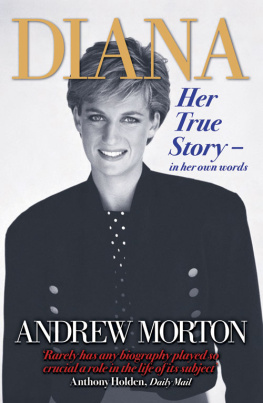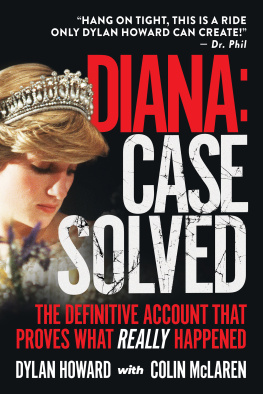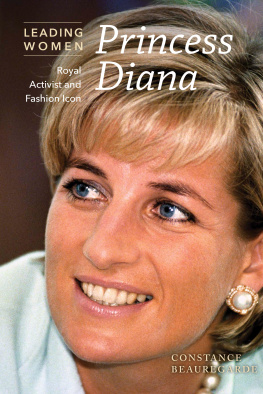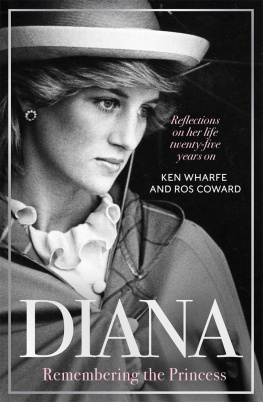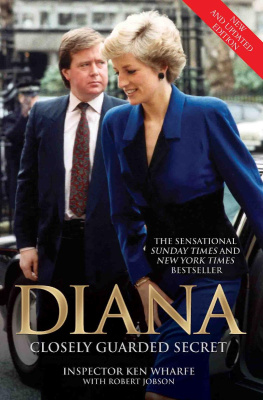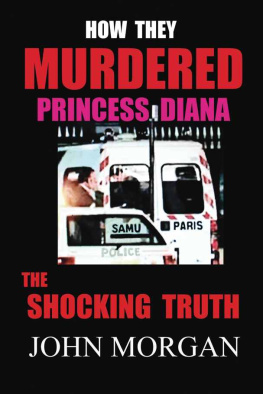Copyright 1999 by Sally Bedell Smith
All rights reserved.
Published in the United States by Random House, an imprint of The Random House Publishing Group, a division of Random House, Inc., New York.
Random House and colophon are registered trademarks of Random House, Inc.
eISBN: 978-0-307-82203-1
www.atrandom.com
v3.1
Contents
 Introduction
IntroductionI n September 1997, when I began my research on Diana, Princess of Wales, I had few preconceived ideas. I felt no partiality toward either Diana or her former husband, Charles, the Prince of Wales, though I had encountered each of them briefly and came away with impressions that seemed at odds with what I had read in the popular press.
I met Charles in the summer of 1991, as the couple were nearing their tenth wedding anniversary, on July 29. The British newspapers were filled with speculation about the state of their marriage. The Sun created a sensation when it published two articles by Andrew Morton describing Charless fondness for Camilla Parker Bowles, a married woman he had known since 1971.
None of the articles mentioned that Camilla had been his mistress for the previous five yearsan open secret in the aristocracy but unknown to the public at large. The tabloids had been similarly circumspect four months earlier when they reported that Dianas riding instructor, Major James Hewitt, had become infatuated with her after having misread her friendliness. At the time, only Hewitts family and a few of Dianas closest friends knew the two had been having an affair since 1986.
The British press did draw attention to the obvious signs of tension between Charles and Diana. Set on separate ways in their private lives, The Sunday Times declared that May, the Prince and Princess of Wales seem increasingly to be bringing their competition and conflict on to the public stage. It is an insidious process that could spell disaster for the monarchy.
On the afternoon of June 15 that year, my husband and I were taken by some English friends to the Guards Polo Club in Windsor Park to watch a Pimms Cup match between a team sponsored by Perrier and a Canadian team called the Maple Leafs. Charles was there without Diana, who couldnt bear watching polo. He wasnt playing because his back was giving him problems; still, he appeared to be in good spirits, and he looked almost American in a blue blazer and sharply creased tan trousers with his slip-on shoes polished to a glistening mahogany.
After the match, we took refuge from the rain in a large tent. One member of our party, a woman in her late seventies, was a close friend of the Queen Mothers. When Charles saw his grandmothers friend, he kissed her on the cheek and called her by her first name. She made introductions all around, and we engaged in small talk. I noticed immediately how comfortable Charles seemed with older women. He was attentive and sweet to his grandmothers friend, solicitous of her health problems, inquiring about mutual friends.
Knowing his interest in holistic medicine, she told him of a practitioner who worked wonders on aching backs, but it turned out the man was a faith healer (much more the province of Diana than Charles), and Charles seemed to lose interest. When my husband made some observations about Charless brother Prince Edward, with whom he had played court tennisa forerunner of lawn tennisat a club in New York several months earlier, Charles said something charming in response. In this familiar setting, chatting with people he knew and away from the prying eyes of the press, Charles was far more natural than the man shown on television performing his royal duties.
My only encounter with Diana was equally informal. In the summer of 1994, Diana and Charles had been legally separated for eighteen months, and their relationship had been further strained by his admission in a television documentary, broadcast in June, that he and Camilla Parker Bowles were lovers. That August, Diana was on vacation in Marthas Vineyard, the guest of the Brazilian ambassador Paolo Tarso Flecha de Lima, and his wife, Lucia, one of Dianas closest friends. A friend had invited me to the Vineyard for a visit with her family, and on August 16, I arrived with my children. An hour later, we were on a private beach for a small buffet lunch with Diana and the Flecha de Limas. Diana was mesmerizingly beautiful in a flowered bikini, her skin perfectly bronzed, her long-limbed figure exquisitely proportioned. My two younger children greeted her properly, but I had no time to brief my nineteen-year-old, who arrived late and breathless after sprinting down the hill. When I quickly whispered to him that the Princess of Wales was there, he exclaimed, No way! then whirled around to be introduced. He pumped her hand vigorously and said, Hey, how are you doing? She seemed genuinely tickled by his Yankee familiarity.
Otherwise, though, she was strikingly subdued, her high beams shut down. After a few feints at conversation around the buffet, I gave up. She seemed preoccupied, and she soon moved into a chair apart from the group to talk intently to our luncheon hostess, with whom she later took a long walk down the beach. Ive pondered Dianas demeanor that day many times since. Here was one of the most charismatic women on the planet, yet she seemed almost without affect. I couldnt figure out whether she was dim and incurious, or troubled and sad. She had not been with her two sons in weeks, and she was surrounded by families with children about the same age as hers. I also knew she had spent the morning with Elizabeth Glaser, a prominent fund-raiser for pediatric AIDS who was dying of the disease, which perhaps explained her subdued manner.
Only years later, when I was interviewing one of Dianas friends, did I hear the words that correctly summed up her manner that day: At times, he said, Diana could be fantastically vacant. She would just switch off. She was unhappy and would let herself give in. Sometimes she would not try a yard. Yet I also learned that she was often more alert than she seemed. In social settings, according to another of her close friends, she would perceive small things. She could pick out all the details about a person, both physical and personality [attributes]. After I met Diana on the Vineyard, she confided to a friend that she felt I was closely observing herwhich I had been trying to do unobtrusively. Her behavior on the beach offered other glimpses of character traits: her intensity in pursuing a new friendshipin this case with our luncheon hostessand her preference for taking the initiative in social situations in order to maintain control.
As I suspected, she had been deeply moved by her visit with Elizabeth Glaser, but I discovered that Diana was suffering for other reasons. The previous day, she had learned that a book about her affair with Hewitt (which had ended in 1991) would be published in the fallbased on their correspondence as well as interviews with him by author Anna Pasternak. Diana had wept inconsolably and had hardly eaten. She was obviously still preoccupied the following afternoon.
When Times Books asked me to consider writing a book about Diana shortly after her death in 1997 at thirty-six, I hesitated. Scores of books had already been written, most of them sensational or superficial or both, by turns condescending, prurient, and fawning. Many were simply newspaper accounts strung together by British tabloid reporters whose tone ranged from hagiography to character assassination, sometimes in the same volume: Diana would appear at one point as a self-possessed superwoman, only to be portrayed pages later as a self-loathing, weepy hysteric, with no explanation for such contradictory behavior.


